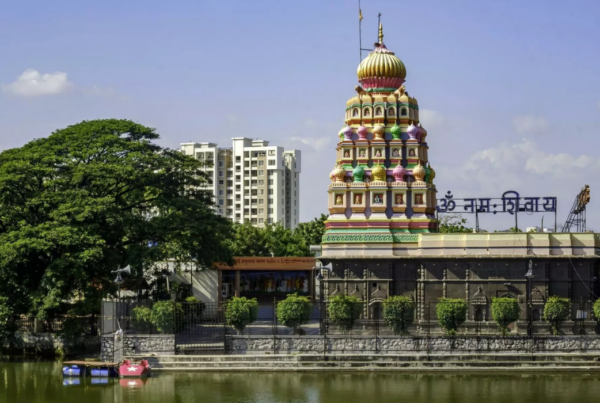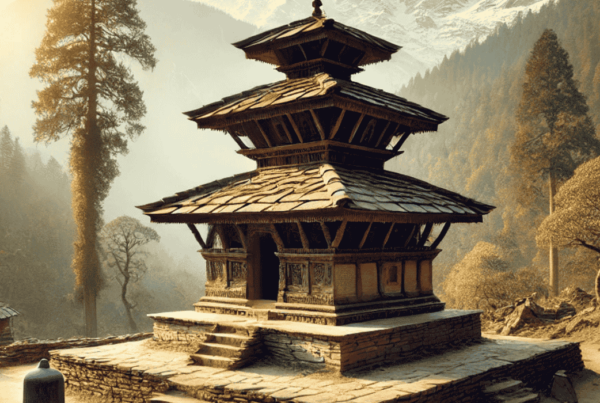History
The Baijnath Temple is one of the most popular temples in Himachal Pradesh. There are various legends associated with this temple. With one being particularly prevalent. According to this legend, the establishment of the Baijnath Temple. Situated in the courtyard of the Dhauladhar mountain range in Himachal Pradesh, was not done by anyone else but Ravana. According to the folklore, Ravana performed intense penance on the Kailash mountain in the Himalayas to please Lord Shiva. When he did not receive the desired results from his penance, he initiated even more severe austerity.
Ultimately, he decided to offer himself as a sacrifice by cutting off his own head and placing it in the sacrificial fire to please Lord Shiva. On this occasion, Lord Shiva appeared and seized Ravana’s hand. Then, Ravana requested a boon from Lord Shiva and expressed his desire to establish a Shiva Linga in Lanka. In response, Lord Shiva granted him two Shiva Lingas with the condition that neither of them should be placed on the ground, as they would get fixed at the spot where they were laid.
Witnessing this, the deities prayed to Lord Shiva to perform a miracle so that Ravana could not take the Shiva Linga to Lanka. After that, an illusion was created, and due to certain circumstances, Ravana ended up placing the Shiva Linga named Baiju on the ground. Despite his attempts to prevent it, the Linga got established, and the other Linga named Baijnath was placed in the courtyard.
This is how both Shiva Lingas were consecrated, and the temple became famous as Baijnath. In the temple courtyard, there are several small shrines and a sculpture of Nandi, the bull. Devotees often make their wishes to Nandi’s ears for the fulfillment of their desires.
Sati’s Sacrifice: Tandava Unleashed
According to the Shiv Purana, after being humiliated by her father Daksha Prajapati for her husband Shiva, Sati jumped into the sacrificial fire and sacrificed her life. Enraged by Sati’s death, Lord Shiva placed her body on his shoulders and began performing the Tandava dance. The sacrificial fire was disrupted, and chaos ensued. In order to control Shiva’s anger, the other gods advised Lord Vishnu to intervene. Vishnu sent his Sudarshana Chakra to cut Sati’s body into pieces so that Shiva’s rage could be subdued.
As Sati’s body parts fell, they landed at various locations, totaling 52 sacred places. In the town of Vaidyanath (modern-day Deoghar), the part of Sati’s body that fell is known as the “Hridya Pinda,” meaning the heart. The place is called “Hridyanath” or “Vaidyanath Dham.” The ritual of cremating Sati’s heart at this location by Lord Shiva is referred to as “Chitta Bhasma,” and the place is also known as “Chittabhoomi” due to this sacred ceremony.
During their period of exile, the Pandavas constructed a temple.
There is another story about how Baijnath Temple was built. Some people believe that during the Dvapara Yuga, the Pandavas, while in exile, constructed this temple. However, there isn’t strong historical proof for this because the temple is made of sandstone.
Mahmud of Ghazni also plundered the Baijnath Temple Himachal
Mahmud of Ghazni was a conqueror who looted several temples in India, including the Baijnath Temple. In 1540 AD, Sher Shah Suri’s army demolished the temple, and later, in 1783, Maharaja Sansar Chand initiated its restoration. In 1905, the devastating Kangra earthquake caused damage to the temple, prompting the Archaeological Department to undertake its reconstruction. The temple’s inscriptions indicate its antiquity, estimating it to be around 2000 years old, highlighting its historical significance.
Dussehra is not celebrated in Baijnath.
Dussehra is not celebrated at Baijnath Temple. There is a popular belief behind this. It is said that Ravana was a devoted worshiper of Lord Shiva. Therefore, a effigy of Ravana is not burned here. Once, some people attempted to do so, but afterward, several natural disasters occurred, causing distress to the people. After that incident, the tradition of celebrating Dussehra at this temple came to an end. Another interesting fact about the city of Baijnath is that there are no goldsmith shops here.
In Magha, on the fourteenth day of the waning moon, a grand fair takes place
In the Baijnath Temple of Himachal Pradesh, a grand fair takes place on the fourteenth day of the waning moon in the month of Magha. This event is also known as ‘Isi Tara Ratri’ or ‘Night of the Stars.’ During this fair, a large number of devotees from far and wide gather. Additionally, apart from this festival, Mahashivratri and the monsoon season attract a significant crowd of Shiva devotees to the temple.
It is believed that visiting this temple during Mahashivratri, the month of Shravan, and on Magha Krishna Chaturdashi brings special blessings and benefits.”
The significance of bathing
Bathing in the sacred Ganges at the Vinava Khadda near the temple holds special significance. Devotees, after taking a dip, perform an auspicious bath for the Shiva Lingam with Panchamrit (a mixture of milk, curd, honey, ghee, and sugar), followed by offering Bilva leaves, flowers, bhang, datura, and other sacred items. This ritual is believed to please Lord Bhole Nath and alleviate one’s troubles and sins, earning spiritual merit.
Baijnath Temple Visit Tips: Heritage, Festivals, and Safety
- Baijnath Temple holds significant importance in India’s cultural heritage, prompting the implementation of security measures to safeguard both the temple premises and the well-being of its worshippers.
- Mahashivratri is enthusiastically observed at this temple, drawing people from across the nation who come to partake in the festivities with great enthusiasm. Consequently, the temple experiences a higher-than-normal influx of visitors, leading to exceptionally long queues.
- Please wear the right shoes when going to the temple, and be ready to remove them before going inside.
- The temple premises are not very generously lit, especially during the evenings. It is advisable to carry a reliable flashlight with you to ensure that your visit is both safe and hassle-free.
- Inside or around the temple, there are no canteens or other food facilities. It’s recommended to bring your own drinks and snacks, ensuring that you won’t be hindered by hunger or thirst while appreciating this exquisite piece of art.
How to reach Baijnath
Train
The nearest railway station is at Paprola, 2 KMs from Baijnath connected to Pathankot through narrow gauge line. And the nearest broad gauge railway station is Pathankot which about 129 Km from Baijnath.
The narrow gauge line from Pathankot pasjses through Kangra, Maranda(Palampur), Baijnath and reaches Joginder Nagar.
By Air
The nearest Airport is at Gaggal, 50 Kms from Baijnath and 8 Kms from Kangra Town.
Also read: 5 Shakti Peethas Of Himachal Pradesh | A Complete Travel Guide
Faqs
What is the mythological significance of Baijnath Temple Himachal?
According to belief, Ravana established Baijnath Temple during his rigorous penance to please Lord Shiva.
Why is Dussehra not celebrated at Baijnath Temple?
The belief at Baijnath Temple is that they do not celebrate Dussehra because they think it is inappropriate to burn an effigy of Ravana, who was a devoted worshiper of Lord Shiva.
Who plundered Baijnath Temple in history?
Mahmud of Ghazni was a conqueror who looted Baijnath Temple, among other temples in India.
What is the historical significance of Baijnath Temple?
Baijnath Temple has a history dating back around 2000 years, with inscriptions indicating its antiquity. It underwent restoration after being demolished by Sher Shah Suri in 1540 AD.
Is there a special fair held at Baijnath Temple?
Yes, a grand fair takes place on the fourteenth day of the waning moon in the month of Magha, known as ‘Isi Tara Ratri’ or ‘Night of the Stars.’
Why is there no celebration of Dussehra in Baijnath?
People at Baijnath Temple do not celebrate Dussehra due to a belief connected to Ravana’s devotion to Lord Shiva.
What is the significance of bathing at Vinava Khadda near the temple?
Bathing in the sacred Ganges at Vinava Khadda holds special significance, and devotees perform rituals to please Lord Shiva.
When did Mahmud of Ghazni loot Baijnath Temple Himachal?
Mahmud of Ghazni looted Baijnath Temple during his conquests in India.
How old is Baijnath Temple according to inscriptions?
Inscriptions indicate that Baijnath Temple is around 2000 years old.
How can one reach Baijnath from Delhi?
To reach Baijnath from Delhi, one can take the rail route via Pathankot or Chandigarh-Una, or opt for transportation by bus, private vehicle, or taxi. Air service is also available from Delhi to Gaggal in Kangra district.








